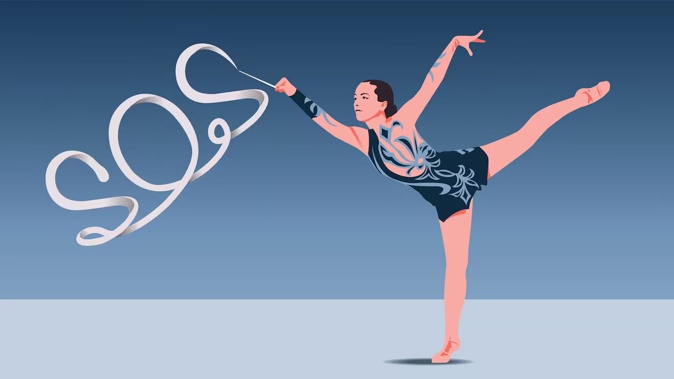
Gymnastics is a sport known for its high level of discipline, requiring athletes to cultivate a diverse array of physical attributes to excel. For competitors in rhythmic gymnastics, the darker realities of the sport can put extreme pressures on young competitors.
In candid conversations with former top New Zealand rhythmic gymnasts - including a Commonwealth Games representative - Bonnie Jansen finds out about the sport’s “toxic” demands and how the athletes continue to grapple with its lingering effects today.
Former rhythmic gymnasts say some young athletes would avoid food because of pressure from coaches and judges to look thin - with some developing severe eating disorders. They say although there is no judging criteria that officially demands competitors should be thin, there is an unspoken expectation that pushes unhealthy body images.
“I always felt pressure to look a certain way,” said a former New Zealand representative* reflecting on her eight-year career in rhythmic gymnastics.
“We are supposed to be slim and skinny, but fit and toned, but not muscular - otherwise you’ll look too bulky. [You need] energy on the floor, but somehow [are] expected to have this energy when you aren’t eating enough to fuel your body.”
Starting rhythmic gymnastics as a 10-year-old in Christchurch - in a competitive squad from the get-go - she told the Herald there was always an idea of perfection.
“Every single aspect about you is judged,” the gymnast said. “You are judged as soon as you enter the floor - the way your hair is done, your makeup, your leotard and how much money it may or may not have cost.
“Rhythmic gymnastics is a catch-22 - nothing will ever be good enough.”
Gymnastics New Zealand last week announced it will refresh its attire rules, allowing athletes to feel comfortable while competing.
The now 26-year-old said eating pressures played a big influence on herself and her competitors.
“Snide comments made about the food you decided to bring for break time by either the other girls in the squad or from coaches encouraging healthier choices.
“But really what they mean is ‘tiny portions’.
“I remember a specific time when I was travelling overseas and I wanted to try a piece of pizza. Later I heard one of the girls in the squad say: ‘She might not want to eat that if she still wants to fit in her leotard’.”
She told the Herald that comment has stuck with her today - nine years after finishing the sport.
“It has affected my self-esteem and makes me take a second thought about what I’m eating on a daily basis.”
She confided that a fellow squad member developed a severe eating disorder and found ways to train more to lose more weight.
“The hurtful truth is, when she started losing weight she won at more competitions.
“[It] just fuels the idea if you’re skinny, the judges will like you more and you’ll win.
“The competitive cut-throat nature of the sport is what drives the unhealthy ways of getting ahead.”
Although there is an “artistry” category in which rhythmic gymnastics competitors are judged on hair, makeup and general appearance, competitors are not meant to be judged on the basis of body weight.

The Russian rhythmic gymnastics team competes at the Tokyo Olympics. Photo / Getty Images
It only takes one comment
Another gymnast who represented New Zealand at the Commonwealth Games told the Herald while she wasn’t directly affected by food constraints, there are still comments and experiences that stuck with her forever.
After 25 years of competing, she said while she hasn’t fallen into that trap of suffering from an eating disorder herself, she acknowledged aspects still affect her.
“It just takes one comment of a passing judge at a different competition or another coach just mentioning ‘you look a little bit bigger’, or ‘oh, you’ve gotten a bit chubby’.”
She said coaches and competitors from other clubs would dish out judgmental comments that could completely derail young competitors.
Competing at the highest level, she said athletes felt pressure to conform to coaches’ expectations about their food consumption. Some would make sure their coach saw them with a small portion at lunch, perhaps as little as “a slice of watermelon or tomato”.
“And then you’ll see them when their coaches aren’t around, and if there’s chocolate or just any sort of food available, they’re just eating as much as they possibly can.”
Unlike some sports where a smaller or larger body size can be a key to success, the Commonwealth Games athlete believes rhythmic gymnasts are encouraged to be small purely for appearances.
“One thing that probably stuck with me the most was I had this one leotard I designed myself and my mum made it for me and I was so excited to wear it,” she said,
“I put it on and my coach told me ‘you can’t wear it at this competition because the other girls are so much smaller’... so I never wore it.
“Thankfully, it didn’t affect me to the point where I wanted to not eat or anything, but that still hurt, and that stuck with me forever.
“It can be very toxic.”
She noted the irony that some of the best athletes in gymnastics do not have smaller body shapes, such as Simone Biles from the United States and Alina Kabaeva from Russia (neither of this pair has competed in rhythmic gymnastics).

Women such as Simone Biles have helped spearhead more open conversations about the mental toll of elite sports, particularly on young athletes. Photo / Doug Mills, The New York Times
Women are judgmental
A third former competitive gymnast and coach told the Herald she perceives the culture of rhythmic gymnastics to be shaped by its predominant representation of female athletes.
“There can be a lot of cattiness, a lot of bitchiness, things that we see when a lot of women are in the room.
“I don’t know of any male coaches. I knew of one male judge - the rest were all female.”
Gymnastics New Zealand told the Herald there is just one male rhythmic gymnast in the country.
The former gymnast also went on to say that due to the standard leotards, there is often nowhere for the athletes in rhythmic gymnastics to hide.
“Body fat is on show. I think that can be quite hard for teens and pre-teens if they are not particularly confident with their body.
“I do remember being a little bit heavier and bigger when I was in my last couple of years of competing and my leotards had to be let out. [It was] a bit of an awkward experience.
“I also remember there were some girls that I had been around that struggled and didn’t want to eat because they were really worried about putting on weight.”
While also noting the success of Biles and Kabaeva, this former athlete noted that most top rhythmic gymnasts are thin.
“The people who are famous in the sport and go to the Olympics and the Commonwealth Games are sticks.
“There’s nothing on them, they’re skin and bones, which doesn’t help.”
She admitted there’s an unspoken rule in rhythmic gymnastics and a sense you need to keep petite.
“It’s probably because everyone else around you is small and petite.
“There wasn’t really another option - it was fit into this body type or don’t.”
In a statement, Gymnastics New Zealand chief executive Andrea Nelson told the Herald that “ensuring athlete safety and wellbeing is the absolute priority of Gymnastics New Zealand”.

The now Gymnastics New Zealand chief executive Andrea Nelson was the Cricket World Cup chief executive. Photo / Photosport
“Following the review of our sport in 2021 and the subsequent work of the steering committee tasked with implementing the recommendations contained in that review, we have introduced a range a measures to safeguard the wellbeing of all gymnasts - many of whom are young women and girls,” Nelson said.
“These measures include ensuring member clubs have fit-for-purpose child safeguarding systems, a new complaints mechanism that makes it easier to raise issues of concern when they do occur, an overhaul of competition attire rules that had caused concerns for some female participants, and improved coach education.
“We are working on updating advice to coaches and clubs around suitable age and stage training loads, which we will be issuing later this year.
“Foreign nationals who come to New Zealand to coach undertake a ‘Coaching Today’ course that includes elements and principles of Sport New Zealand’s Balance is Better programme, as well as child protection information. This course is mandatory.
“GNZ recognises that there have been issues in the past that have led to athletes experiencing harm, and we continue to work to ensure current and future athletes are not exposed to the practices that caused that harm.
“We do ask that if anyone is aware of anything currently occurring in our sport that could jeopardise participants’ safety and wellbeing at any level of the sport that they inform us so that we can take any action required to resolve these issues.”
* The Herald has agreed not to name the three gymnasts interviewed for this story.
Bonnie Jansen is a multimedia journalist in the NZME sports team. She’s a keen footballer, passionate about women’s sport and was part of the Te Rito cadetship scheme before becoming a fulltime journalist.
This story was originally published on the Herald, here
Take your Radio, Podcasts and Music with you









